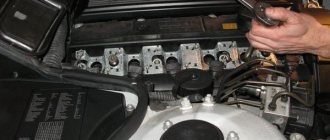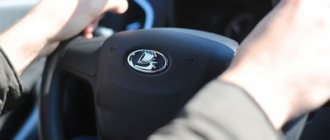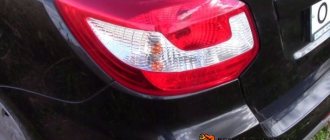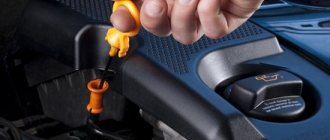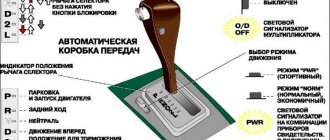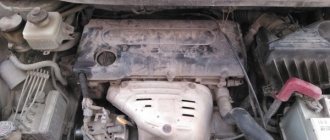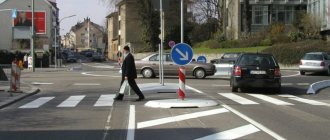“How to park correctly?” - this question torments absolutely every novice car enthusiast. The Internet is simply replete with various funny videos on the topic of illegal parking. Thousands of knocked-down poles, scratched cars and many other unpleasant moments associated with parking force you to put aside all your affairs and plunge into an article devoted to the rules of proper parking. We hope that the material presented below will help you avoid all the troubles and become an expert in the ability to carry out proper parking.
Diagonal parking
Typically, diagonal car parking is organized in places where there is a large concentration of cars: in front of large shopping centers, business centers, and stadiums. From a practical point of view, this is the easiest way to park. It will not be difficult even for a beginner to drive into a parking space. You must leave such a parking lot along the same trajectory, making sure that there are no cars passing behind you.
To visually consolidate information on proper parking of a car, a diagram of the location of parked cars and the trajectory of your car’s movement drawn with arrows can help. You can also borrow your child’s cars and briefly relive your childhood, learning how to park a car in various ways, connecting visual and tactile memory.
Park Assist system for automatic car parking without driver intervention
The car parks itself! Is this really possible? Yes, some cars equipped with this system allow the driver not to think about the intricacies of parking. The Volkswagen Touran parks itself using an on-board computer and ultrasonic sensors.
In order to park, you need to activate the system. If you drive one and a half meters away from parked cars at a speed of 30 km/h, the system will automatically select a space sufficient for parking. The driver, at the signal on the information board, must ensure that reverse gear is engaged and can release the steering wheel. So far this is the only car supplied to Russia with such a system. Automatic parking systems are installed by manufacturers on many modern cars from Lexus, Citroen, Volvo, Audi and others.
See how Park Assist works in the Audi A6.
Rules for parking on the roadway, in yards and in parking lots
Parking rules on the roadway are most often violated. So, in order not to become one of the violators, you should adhere to the following provisions:
- stopping is allowed away from the pedestrian crossing at a distance of 5 meters;
- You can stop immediately after a pedestrian crossing;
- at the edge of the roadway (only parallel to the edge);
- no closer than 5 meters from the turn at the intersection;
- near signs that regulate parking on even or odd dates;
- anywhere on the roadway, if the driver’s vision covers at least 100 meters of the road ahead;
- at a distance of 15 meters from stops;
- on the right side of the road (if there is no road side, parking at the edge of the roadway is possible);
- at the edge of the sidewalk, if there is a corresponding sign (applies only to cars, mopeds, motorcycles and bicycles).
You can also leave your car for a long time in places outside the populated area, if they are equipped with the appropriate sign. It is prohibited to leave a car on the road for such a purpose, as well as on the side of the road. There are special parking areas, equipped separately.
How to choose a parking spot
Do not leave the car where it can interfere with other drivers entering or leaving, block the path for pedestrians, or complicate the movement of buses and trolleybuses. All the main nuances are listed in the traffic rules. Pay attention to the territory, whether there is construction debris, poles, destroyed trees, unfinished construction without fencing. Such places are not suitable for parking. In winter, leaving a car close to a multi-story building is dangerous. Ice accumulated on roofs can damage your car. One of the residents may throw cigarette butts, garbage, or waste out the window. You will have to spend a lot of money to repair the hood, roof or windshield.
Reverse parking methods
There are certain ways to park in reverse, which have clear instructions and diagrams on how to do it. You can, of course, park the old fashioned way, when there were no different tricks, that is, you turn your head and drive back. This method is used by many who are not used to navigating by mirrors.
The main skill is acquired through practical application. If you recently bought a car, you can go to large sites in your free time and practice in different ways. If you immediately install parking sensors, it will be much easier, but you will not learn to park according to the schemes developed by specialists.
To learn how to properly reverse park a car, the mirrors must be adjusted so that they can see the area behind the car and on the sides. Everyone can have individual techniques. For example, some drivers lower the right mirror so that part of the rear wheel is visible. This is usually done if the rear has a high curb that could damage the bumper.
You need to develop the habit of parking correctly. Fines for illegal parking can be 1500, 3000, 5000 rubles. Also, in some cases, the car may be taken to an impound lot.
Instructor Tips
In addition to memorizing the technique and practical exercises, beginners will also benefit from advice from experienced instructors. Here are the most important of them:
- Take your time! As you know, if you hurry, you will make people laugh. But in the case of traffic, laughter probably doesn't end the matter.
- Look in all directions during any maneuver.
- It is usually difficult for an inexperienced driver to navigate using mirrors. Therefore, for the first time, it is better to do parallel parking outside a driving school “as a couple” - ask the person who is traveling with you, get out and “conduct.”
- Learn the instructions (all your steps) by heart.
- For training, some experts recommend using balloons on the sides; they will tell you when the car is likely to hit a curb or another vehicle.
- Be as focused as possible. Even if you are slowing down the traffic of nearby cars, and she began to “express” her dissatisfaction with the buzzing, not to mention the ringing of the phone, nothing should distract you. You must park correctly. Everything else will wait.
Algorithm
Choose a suitable place where you will park your car, drive up to it. Your task is to park in reverse. The scheme involves stopping about a meter from other parked cars. Next, draw a mental line. It will start at the center of the rear wheel and end at the level of the seat. When you connect it to another vertical line, you get a point. It should be somewhere around the rear wheel arch. Mentally find the point on the marking where you will turn.
Turn right and reverse gear. When the line connects with the parking spot, turn the steering wheel one and a half turns. Drive as slowly as possible
It is important to feel the dimensions of your car. Head straight to the center of the parking lot
When you stand parallel to others, align the wheels. Then move back further until you stand next to others. Always look back and to the sides
Also pay attention to mirrors. Reverse parking between two cars or any other method requires concentration and attention, especially for beginners
Also keep in mind that you will need to get out somehow. Therefore, estimate the distance that is enough to open the doors. Master this algorithm until everything comes out automatically. If you are not sure yet, buy parking sensors. This way you will protect yourself and other cars.
Such a scheme and skills will be very useful to you on the road. This is nothing more than parking in reverse between cars. It's just that instead of other cars you have a garage. But the algorithm of actions is the same.
Table of contents
- The biggest mistake newbies make
- Parallel parking rules
- Perpendicular parking
- Reverse parking
- Diagonal parking
- How to choose a parking spot
- Constant practice
Each method has nuances that are important to follow. Knowing them, parking a car for novice drivers will be easy and fast. How to overcome the fear of trying to stop at a curb or enter a garage? An article about proper parking will answer all your questions.
Types of parking and nuances
The simplest type is straight parking, in which the car stops along a certain object - for example, a fence or curb - in a straight line.
When performing direct parking, you need to try not to get “butt up” to a nearby vehicle, since the process of leaving in this case can become very problematic.
Direct parking in front can be done only if there is free space, but in most cases there is no such space and you have to park linearly in reverse, allowing you to fit exactly into the free space.
A couple of tips for a snack
When parking behind a car, do not forget to leave enough free space in front of you to freely leave the parking lot if it is not possible to reverse. Strictly ensure that you maintain a distance from nearby cars when parking crosswise! The most optimal distance between neighboring cars should be equal to the width required for free opening of the driver or passenger door of the car. Otherwise, opening the door may damage a car parked next door. Be careful when approaching the edge of the sidewalk. Lack of proper distance between it and your car can cause it to hit the curb or other nearby objects.
We hope that the above material will allow you to more quickly master the skill of proper parking. The absence of haste and fear will serve you well in this difficult task and will allow you to easily and easily cope with any complex maneuver.
General parking recommendations
Before you start parking, try to assess whether there is enough space for maneuver, whether you will hit someone else’s car, or whether you will create inconvenience for other drivers and passersby? Is parking allowed in this place in terms of traffic regulations?
Very often, car owners do not take into account the characteristics of a particular car, and this is very important for proper parking. The vehicle's maneuverability when driving in reverse is always higher than when driving forward.
Therefore, parking using reverse gear is much more maneuverable than conventional parking.
The vehicle's maneuverability when driving in reverse is always higher than when driving forward. Therefore, parking using reverse gear is much more maneuverable than conventional parking.
It is better to place your hands at the top point of the steering wheel, this will allow you to maneuver more efficiently.
All-wheel drive cars boast a maximum turning radius. But with rear-wheel drive cars you need to be extremely careful - their turning radius leaves much to be desired
Step-by-step parking instructions
Step 1
Choose a parking space that matches the dimensions of your car (take into account that the free space should be at least 1.4-1.5 times the length of your car).
Step 2
When starting the parking process, you should drive a little further from the car in front, but there is no need to press close to it. Stand parallel to the front car you will park behind. A lateral interval of 50 cm to 1 meter is considered normal. Compare the rear bumper of your car with the neighboring one.
Step 3
Turn the steering wheel all the way to the right and slowly back up. When the headlight of the rear car closest to the curb appears exactly in the middle in your mirror, stop, turn the steering wheel back and put the wheels straight. (Or in the right side mirror in front of the (bumper) of the car standing behind you should become fully visible..) (Or the left rear corner of your The car should be level with the front corner of the car that is behind.)
Step 4
Slowly move backward until the front bumper of your car roughly crosses the border of the car in front (when the front bumper of the car is level with the rear bumper of the car in front)
Step 5
After this, turn the steering wheel to the left and continue to move back slowly and carefully. Drive as close to the car behind you as possible and stop. Be sure to look at the car in front so as not to hit it with your bumper. If you are not standing quite parallel, turn the steering wheel all the way to the right (towards the curb) and shift forward slightly. When the car is parked, return the steering wheel to the center position.
Technical side of the exercise
Now we will look at each stage in more detail so that you know what to expect in the exam and how to pass it successfully. The first step is to drive up to the starting line and stop without crossing the line with your bumper. After stopping, neutral gear is engaged
You should immediately pay attention to the “neutral”: if you do not switch the car to it, you can get a penalty point
Next, we move off and begin to slowly move forward. When approaching the “garage” you need to press the right side of the car closer to the first chip - the beginning of the right wall of the garage. If this is not done, there may not be enough space to continue the exercise and you will not be able to complete the race.
Thus, we reach the indicated chip with the right mirror and turn the steering wheel to the left all the way. The car is now moving to the left. When driving, keep the steering wheel securely in the left position, preventing it from turning in the opposite direction. We also look carefully in the mirror on the right - in it you need to catch a chip, which is the beginning of the wall on the right relative to the car. This chip should be located at a certain distance from the side of the car - 10-15 centimeters. This is exactly how everything should be reflected in the mirror.
As soon as all the above conditions are met, stop the car and put the wheels in a level position. After that, we turn on the reverse gear and start moving back in a straight line.
Now we turn around and look out the rear window. To make it more comfortable, you can hug the front passenger seat with your right hand. We watch how the car gradually drives into the designated place, but up to a certain point. When a marker appears near the right rear door - the beginning of the garage wall - we stop again.
The next step is to turn the steering wheel to the right all the way and resume moving backwards. We carefully monitor what is happening in the mirrors. When the distances between the side features and the sides of the car are the same, quickly level the steering wheel and put the wheels in a level position, without stopping or slowing down.
We drive deep into the “garage”, and when the front of the car crosses the line of chips - the beginning of the walls - we stop, turn on the neutral gear and put the car on the handbrake.
End. The exercise of driving into the garage in reverse is completed, the car is in the right place and you can already relax.
If you do everything as described above, this will guarantee you a 99% success rate in passing the exam.
The ability to steer and move competently is the key to safety when parking backwards
In theory, driving backwards is very easy. If you turn the steering wheel to the right, the car will turn to the right, and vice versa. When a novice car enthusiast leaves the walls of the racetrack, and there is no longer an experienced instructor nearby, this knowledge disappears somewhere.
To prevent parking a car in reverse from leading to accidents, you need to master the skill of driving slowly in reverse. If this is not the case, then you do not need to fully release the clutch pedal. Here it is recommended to work more impulsively. If you need to move, release the pedal; if you want to start rolling, press the clutch pedal to the floor. Don't put too much pressure on the gas.
Some novice drivers, who receive important knowledge and driving lessons in various driving schools, learn to drive in reverse only using the clutch. No gas at all. It is not right. In real conditions, situations are different.
Regarding the steering, you can also note that for beginners it is better to use the rear window as a windshield. So, just turn the body back. Turning the steering wheel will turn the rear of the car to the right, and vice versa
It is important to understand that absolutely any car is more maneuverable when in reverse. There are sharper turning angles
It is important not to lose the position of the steering wheel, in which the car drives straight.
This knowledge and skills are very important. Without them, you won't be able to park correctly. This can lead to ridiculous accidents, scratched foreign cars and various troubles.
Is it possible to park on the sidewalk?
You cannot park on the sidewalk unless there is a sign and one of the signs.
A sign with the letter "P" indicates that parking is permitted. It is also necessary to pay attention to how you can park on the sidewalk
If the driver, due to his own laziness or forgetfulness, left the car on the sidewalk (or worse, deliberately), then he has thereby committed an administrative offense under Part 3, Article 12.19 of the Code of Administrative Offenses of the Russian Federation. Even if the car does not interfere with the passage of pedestrians, you will still be held accountable (tougher since 07/1/12). The penalty for violation depends on local regulations.
There is something worse than a fine - the inadequate reaction of angry pedestrians, which can lead to deliberate damage to the car.
A car was doused with paint for parking on the sidewalk
A more harmless version of censure for illegal parking was invented by the Novokuznetsk traffic police: traffic police officers and their young assistants paste a sticker on the rear window of the cars of fines with the inscription “I park like a deer!”
Such stickers are applied by traffic police officers of Novokuznetsk
Parallel parking
Parking in reverse is quite simple, although many people do not know about it. Of course, when driving backwards, there is some risk of scratching nearby cars, but there are many options when parking can only be done using this method.
This type of parking, with the necessary skill, is convenient for competent maneuvering; with its help, you can very accurately occupy the parking space that was originally planned.
For example, parking in front is possible when there is a large free space between two adjacent cars.
If it is missing, you risk damaging someone else's property or leaving the rear of your car protruding from the row.
So, you must first align with the car in front of the parking space. The distance between you should be within 0.5-1 meter. Then estimate the turning zone - it is oriented along the right wheel.
You need to build an imaginary line upward from it - this “mark” will become a safe turn indicator for you.
When reversing, you need to start moving until this line aligns with the rear of the car that is on the right.
After this, the steering wheel is twisted to the right, and you move backwards until you see the right front of the car that is behind you - after that you need to put the wheels straight.
Then continue driving until you see the rear of the car in front of you.
All that remains is to level the car to equalize the distances from the cars parked next to yours.
As you can see, no one sets super-tasks for you. But, of course, learning how to parallel park correctly will require training.
By the way, remember one useful tip: to calculate the size of the space needed for rear parking, you need to add 1.1 meters to the length of your car - then you can park easily.
How to learn to park correctly
In driving courses, when you are trying to learn how to drive a car, they don’t pay much attention to the question of how to learn to park correctly. The instructors believe that if you know how to drive a little and know the basic rules, then you can easily park anywhere and in any situation
But this is far from reality. Sometimes the process of parking itself only brings negative emotions, and you can’t really enjoy driving. Next, we will give tips on correcting mistakes when parking a car.
Parking Size Estimation
One of the most common mistakes is misjudging the size of the location where you decide to park your vehicle. This happens because drivers do not take into account the size of their car. If you cannot park right away, then it is better for you to do several training sessions with a knowledgeable driver who will help you and point out all the mistakes.
Selection of parking space
Often the driver cannot immediately choose a suitable parking place. Before parking, you need to take a good look at the street in front of you to see if there is a suitable space for your car. If you choose a spot in advance, you won't have to brake suddenly or squeeze into a short distance. All you have to do is drive carefully.
Outdoor parking near the house
An open area in the local area, used as a parking lot, is a painfully familiar, but fairly modernized option. It is also the most profitable for the developer and residents because:
- the developer does not have to overpay, increasing the project estimate;
- Apartment owners do not have to shell out significant amounts of money to purchase a parking space.
But such parking lots are available only in new buildings on the outskirts of the city and in the suburbs, where the expansion of the local area does not greatly harm the infrastructure of the area.
Among the disadvantages of open parking, it is worth noting that cars are not protected from the actions of intruders or the influence of weather factors. Also, the presence of many cars in the yard can create some discomfort for the residents of the house and have a negative impact on the environment.
Basic parking rules
When parking, the driver must control the overall situation - for this it is important to learn how to quickly and accurately focus attention. If you don’t know how to park in reverse (backwards), remember the main rule: when parking, not only turn your head, but also do not forget about the mirrors. If you turn your head, your visibility increases, but there is still no way to see obstacles that are below the glass level
If you turn your head, your visibility increases, but there is still no way to see obstacles that are below the glass level
If you don’t know how to park in reverse (backwards), remember the main rule: when parking, not only turn your head, but also do not forget about the mirrors. If you turn your head, your visibility increases, but there is still no opportunity to see obstacles that are below the glass level.
Of course, the mirrors have a narrow view, but they have a good viewing sector, allowing you to more accurately approach an obstacle - in other words, the degree of maneuverability of the vehicle increases.
You should also not forget about the features of your own car - for example, cars with rear-wheel drive have a minimum turning radius, and all-wheel drive ones have a maximum.
Try to imagine in your mind the trajectory of movement when parking, figure out how the axles of the car move - clearly imagine this picture, because this way it is much easier to master the art of parking correctly.
The biggest mistake newbies make
Fear of parking the car incorrectly, miscalculating the distance to an object, crashing into another car, or scratching your own. All this leads to the driver becoming lost and unable to concentrate. This behavior makes parking difficult and often leads to accidents. A driver who is not confident in his actions is not able to control the process.
The first rule is to get rid of fear. You need to get used to the dimensions of the car and feel them. Grip on the steering wheel is equally important for parking. This skill allows the driver to quickly react and make decisions in a dangerous situation. Another cause of an accident is an attempt to park close to the curb. The driver must be able to visually assess the height of the obstacle. Otherwise, damage to the bumper cannot be avoided.
The ability to park in reverse is difficult. All due to a vague idea of the vehicle’s dimensions. You need to compare the dimensions of the car and the size of the garage. Often a distance of 10-15 cm is maintained between the wall and the mirrors. This space is enough to drive inside without damaging the car.
Come to our parking courses! View course
